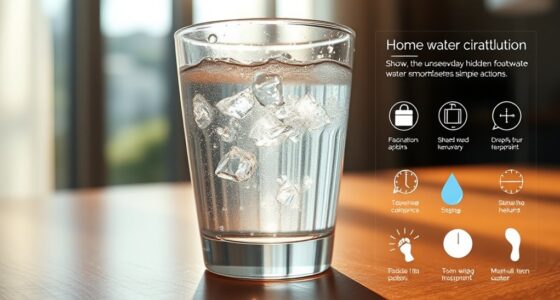Plastic-eating enzymes show real promise for tackling plastic waste, but they face significant scientific and practical hurdles. These enzymes can degrade plastics like PET, but their efficiency is limited by plastic durability and environmental conditions. Advances in enzyme engineering aim to improve stability and activity, yet challenges remain in scaling up and ensuring ecological safety. While hopeful, it’s important to recognize that these solutions are still evolving; exploring further reveals how close they are to becoming a viable part of waste management.
Key Takeaways
- Plastic-eating enzymes show promise but face challenges in efficiency and stability under real-world environmental conditions.
- Engineering efforts aim to enhance enzyme activity, but large-scale application and cost remain significant hurdles.
- Current enzyme solutions are part of a broader strategy, including recycling and biodegradable materials, not a standalone fix.
- Environmental factors like temperature, pH, and contaminants limit enzyme effectiveness in natural settings.
- While progress is steady, enzyme technology alone is unlikely to fully solve the global plastic waste crisis soon.

Have you ever wondered if it’s possible to reduce the massive plastic waste crisis? It’s a question that has sparked hope and skepticism in equal measure. Scientists are exploring innovative solutions, and one of the most promising areas involves plastic-eating enzymes. These specialized enzymes can break down plastics like polyethylene terephthalate (PET), which makes up bottles and packaging. But despite the excitement, there are significant hurdles to overcome. Biodegradation challenges, for instance, make it difficult for these enzymes to efficiently degrade plastics in real-world environments. Plastics are designed to be durable, resistant to natural degradation processes, which means the enzymes often struggle to access and break down the material effectively. This resistance limits their current utility, especially at the scale needed to address global waste problems.
Plastic-eating enzymes face hurdles in breaking down durable plastics in real-world environments.
To tackle these issues, researchers have turned to enzyme engineering—an advanced field that involves modifying enzymes to boost their performance. Through enzyme engineering, scientists attempt to enhance the stability, activity, and specificity of plastic-degrading enzymes. The goal is to create variants that can work faster and more efficiently under environmental conditions. For example, by tweaking the enzyme’s structure, they aim to improve its ability to bind with plastics and catalyze their breakdown. These efforts are promising, but they are not without obstacles. Engineering enzymes that can withstand diverse environmental conditions—such as varying temperatures, pH levels, and presence of contaminants—is complex. Achieving the right balance between enzyme activity and durability remains a significant challenge.
Moreover, deploying these enzymes at the scale necessary to make a meaningful impact involves logistical and economic considerations. Producing enough enzyme in a cost-effective way, ensuring they remain active in natural settings, and preventing unintended ecological consequences are all hurdles scientists are diligently working to overcome. Despite these challenges, progress is steady. Researchers are experimenting with different enzyme variants, leveraging artificial intelligence to predict improvements, and testing enzyme applications in various waste management scenarios. Additionally, advancements in enzyme engineering are helping to tailor enzymes to specific environmental needs, increasing their potential effectiveness. While enzyme engineering offers a promising pathway, it’s important to recognize that it is not a silver bullet. It’s part of a broader effort that includes reducing plastic production, increasing recycling, and developing biodegradable materials.
In addition, understanding the contrast ratio of these enzymes’ effectiveness in real environments is crucial for assessing their potential impact. Despite these challenges, progress is steady. Researchers are experimenting with different enzyme variants, leveraging artificial intelligence to predict improvements, and testing enzyme applications in various waste management scenarios. While enzyme engineering offers a promising pathway, it’s important to recognize that it is not a silver bullet. It’s part of a broader effort that includes reducing plastic production, increasing recycling, and developing biodegradable materials.
In the end, plastic-eating enzymes represent both hope and hype. They showcase human ingenuity and the potential for scientific breakthroughs to address environmental crises. But real-world impact will require continued research, collaboration, and systemic change. As you follow these advancements, remember that while enzyme engineering brings us closer to manageable solutions, solving the plastic waste problem demands a holistic approach, blending innovation with responsible consumption.
Frequently Asked Questions
How Scalable Are Plastic-Eating Enzymes for Global Waste Management?
You wonder how scalable plastic-eating enzymes are for global waste management. Currently, enzyme sustainability and production scalability pose challenges, but advances are promising. You can help by supporting research and innovations that improve enzyme efficiency and cost-effectiveness. As technology progresses, these enzymes could become more viable for large-scale use, making waste management more sustainable. Your involvement and awareness are key to turning this potential into a practical solution.
What Are the Environmental Risks of Deploying These Enzymes Widely?
When considering the environmental risks of deploying plastic-eating enzymes widely, you should be aware of biosafety concerns. These enzymes could unintentionally affect non-target species through gene transfer, potentially disrupting ecosystems. If the enzymes spread beyond intended areas, they might evolve or transfer genes, causing unforeseen ecological consequences. Consequently, careful regulation and thorough testing are essential to minimize risks and guarantee safe, responsible use of this promising technology.
Can Plastic-Eating Enzymes Break Down All Types of Plastics?
Considering the current question, you should recognize that plastic-eating enzymes are quite specific; their enzyme specificity limits them to certain plastics. While scientists have made strides, they can’t yet break down all types of plastics due to plastic diversity. You must understand that these enzymes excel with some plastics but stumble with others, highlighting that enzyme efficiency varies, and broad-spectrum solutions remain a challenge in tackling the plastic pollution problem effectively.
How Cost-Effective Are Enzyme-Based Plastic Recycling Methods?
You might wonder about the economic feasibility of enzyme-based plastic recycling. Currently, these methods can be costly due to enzyme production and process optimization, limiting market adoption. While they offer promising environmental benefits, scaling up remains a challenge. To become more cost-effective, innovations are needed to reduce expenses and encourage wider market acceptance, making enzyme-based recycling a practical alternative to traditional methods.
What Are the Ethical Considerations in Using Genetically Modified Enzymes?
When considering genetic modification ethics, you should think about the environmental impact and potential risks. Using genetically modified enzymes raises concerns about unintended effects on ecosystems and biodiversity. You might question whether the benefits outweigh the ethical dilemmas of altering organisms. It is crucial to weigh the promise of improved plastic recycling against possible ecological harm, ensuring responsible use while respecting natural processes and addressing societal concerns.
Conclusion
So, next time you toss that plastic bottle, just remember—you’re basically inviting a tiny creature to eat away at your conscience too. These so-called “plastic-eating enzymes” might be the superhero we need, or just another sci-fi fantasy with a fancy label. Don’t hold your breath for a miracle, but if they do work, maybe we’ll finally have a villain to blame—besides ourselves. Until then, keep pretending recycling is enough.










